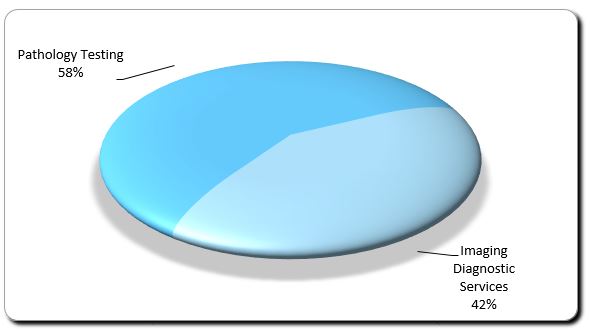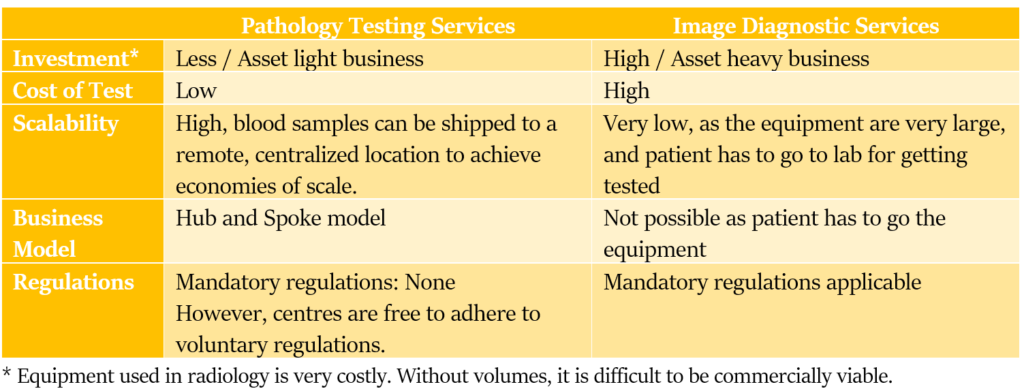This blog will continue the discussion on Diagnostics Market Segment. (Featured image credits: https://www.drmaidhospital.in/diagnostic-services-in-multispecialty-hospital/)
In the last blog, we saw that the diagnostics market can be segmented in 5 different ways. We also discussed the first 2 kind of segments.
- Industry structure as Unorganized Vs Organized
- Geographical demographics as Urban Vs Rural
In this blog, we will cover the below 3 ways of segmenting the market.
- Purpose/Stage of diagnosis as Prescriptive Diagnostics Vs Preventive / Wellness Diagnostics
- Services offered as Pathology Testing Services and Imaging Diagnostic Services
- Segmentation based on the Complexity of Tests
Before we proceed any further, let me clear a question that could be in your mind. In what way is the understanding of this market segmentation (or sub-segments) important for an investor?
We saw in one of our earlier blogs that the Diagnostics Industry is a Heterogenous industry with many segments and sub-segments. Each of these has different business dynamics, profitability, competition etc. As you analyze the different companies in the listed space, you will find that these companies focus on different segments, geographies and even unique business models. An understanding of these market segments is essential in your analysis. It helps to evaluate the company in terms of competitive edge, moat, profitability etc.
Brief Background of this Blog Series
Diagnostics Industry was of interest to me since 2017. However, I could spend dedicated time only during 2021 to study this industry. The contents that you see in the coming blogs were mined from Annual Reports, Concalls, RHP, Management interviews and a few Twitter spaces by Mr Aditya Khemka and Dr Velumani.
Hi, This is Venkatesh. I write on Personal Finance, Stock Investing, Productivity and Time Management. You will be interested to read more about me and the purpose of my website.
If you are interested in these topics do subscribe to my blogs. You would maximum receive 4 to 5 emails a month.
You might also be interested to read these related articles:
Prescriptive Diagnostics Vs. Preventive/Wellness Diagnostics
- Preventive/Wellness diagnostic services are aimed at identifying pre-existing diseases or the likely risk of particular diseases before the onset of actual symptoms.
- It is expected that these tests will assist people to more accurately identify risks so that they can take corrective or precautionary measures before any chronic condition occurs.
- These tests are generally aligned to either specific screen for a chronic disease or contain a series of tests to ascertain the overall health condition of an individual.
- The package mostly contain biochemistry tests to check an individual risk for chronic diseases. Some labs may however bundle it with a few radiology tests like ECG or a Ultrasound in their test package.
- Diagnostic chains and hospital-based diagnostic centres are increasingly marketing their test menus for the preventive and wellness packages.
In these tests, customers themselves go to the lab, and get the test done. They do not have any referral or recommendations from a doctor. They are aware of what test is needed and also able to form an opinion on the results. They do this by comparing the results with reference values. If some values are not within the range, they then consult a doctor. This is in contrast to prescriptive diagnostics where the doctor prescribes the required test to the patients based on the illness.

Source of data in the pie chart: Understanding the Diagnostics Lab Business https://youtu.be/nzNHOP5GONU, By Mr. Onkar Raunak of PPFAS Mutual Fund
Pathology Testing Services and Imaging Diagnostic Services
The diagnostic industry can be classified based on the services offered as:
- Pathology Testing Services
- Imaging Diagnostic Services
Pathology Testing Services
This involves (1) Collecting the samples, in the form of blood, urine, stool, etc., (2) Analysing the samples using laboratory equipment and technology, to arrive at useful clinical information, in order to assist with treatment of patients’ diseases. As part of analysis the specimens are mixed with chemical compounds called as reagents.
Note: Reagent has an important part in the business model of pathology testing and is discussed in detail in the upcoming sections.
Image Diagnostics Services
These tests involve imaging procedures such as X-rays and ultrasounds, which help to identify anatomical or physiological changes inside a patient’s body. This service is also called as Radiology.
Of these two, Pathology accounts for the largest share (58%) in the diagnostic industry.

Source: Vijaya Diagnostics Annual Report 2022.
Why are the volumes in Pathology higher than Radiology?
- Pathology testing has gained prominence as the preferred first line of diagnosis for a majority of diseases, and thus contributes to a major portion of the diagnostic industry
- This has led to a gradual increase in the prescription of pathology tests over the last few years
- The price for pathology investigation is usually lower than for imaging diagnostic tests such as MRIs, where each test may cost two to three times more than the pathology investigation.
- Pathology investigation requires several tests for a patient at one time.
- At times, these tests are conducted frequently i.e. Diagnosis of the disease, during medication and post recovery for confirmation, in different stages of life cycle of the treatment.
Thus, the contribution of pathology tests to the overall diagnostics market is on the higher side.
Key Differences
Below are the key differences between these two services

Note: The Hub and Spoke model in the table above forms a core part of the scalability in the Pathology business. This shall be discussed in detail in subsequent blogs.
Segments Based on Complexity of tests
Pathology
Routine Testing
Routine tests generally are performed on blood, serum, plasma and other body fluids & specimens such as microbiology samples. The common routine tests are,
- Basic bio-chemistry tests: Blood sugar for diabetes, cholesterol, HIV, pregnancy, and creatinine for kidney function.
- Basic haematology tests: Blood count and
- Clinical pathology tests: Routine urine examination.
Semi-Specialized Testing
- Special chemistry parameters such as amylase and lipase for pancreas function
- Immunoassays such as Thyroid function tests
- Microbiology tests such as bacterial culture to identify infection
- Cytology, the study of body fluids and
- Vitamin tests
Specialized Testing
- Special chemistry parameters such as amino acids for metabolic disorders;
- Coagulation parameters such as Protein C and Protein S for coagulation disorders;
- Immunoassays parameters such as acetyl choline receptor antibodies for diagnosing myasthenia gravis and allergy tests;
- Microbiology tests such as mycobacterial culture to know tuberculosis infection;
- Histology, study of tissues for cancer diagnosis using immunohistochemistry stains;
- Molecular diagnostics such as viral load assays for HIV and hepatitis; and
- Cytogenetics such as karyotyping of blood and bone marrow for genetic disorders.
- Others: Genetics, immunology, oncology, endocrinology etc.
Source: Metropolis DRHP Page 147
Note: Given the complexity of Semi-specialized and specialized testing, these tests require highly skilled, well trained personnel, high precision equipment and/or instruments of sophisticated technology, specialized collection and transport methods. Due to this the cost of testing is high. Small labs are not able to do these tests due to the huge investment in personnel, equipment and needed infrastructure. Large diagnostics chains are able to perform these tests. Thus, the competition intensity in these tests is less when compared to routine test, leading to better margins.
Radiology
Basic Radiology Tests
These tests include ECG, X-rays, ultrasounds, mammography and bone mineral density scan.
- X-rays: These machines use “roentgen rays” to penetrate the body and record images of organs and structures on a film. They are used to detect bone disease, degeneration, fractures, dislocations, infections and tumours in the human body.
- Mammography: It can be seen as a special form of X-Rays. It uses low density X-Rays to visualize breast tissue. It is a primary test for detecting breast cancer. These tests are used only for the diagnosis and treating breast cancer.
- Ultrasounds: It is an imaging technology that uses high frequency sound waves. A probe sends an ultrasound pulse into tissues and receives an echo back. This forms an image on sonography machines. These tests are used from confirming and dating a pregnancy to diagnosing a wide variety of conditions affecting the organs and soft tissues of the body, including the heart and blood vessels, liver, gallbladder, spleen, pancreas, kidneys, bladder, uterus, ovaries, eyes, thyroid, and testicles.
- Bone Densitometry: This is also called DEXA (Dual Energy X-ray Absorptiometry). These tests are used to measure the bone density of spine, pelvis, lower arm and thigh and detect osteoporosis.
Source: Vijaya Diagnostics 2022 Annual Report / Krsnaa Diagnostics RHP
Advanced Radiology Tests
Advanced radiology tests include CT scans, MRI scans and highly specialized nuclear medicine tests such as SPECT (gamma scans) and PET-CT scans. These tests require advanced machinery to conduct such tests.
- CT Scans: These provides high-resolution image of the organs, bones, soft tissue and blood vessels. It helps to detect medical conditions such as communicable diseases, trauma, musculoskeletal disorders, appendicitis, heart disease, and cancer.
- MRI Scans: These tests use a strong magnetic field and low energy electromagnetic waves. The result is high-resolution, 3D cross section images of body tissue. It helps to examine various parts of body which include brain, spinal cord, bones and joints, breasts, heart and blood vessels and other internal organs such as prostate gland, uterus and liver and diagnose various medical conditions.
- SPECT Scans: These are used for therapy of various diseases and gamma scans provide crucial functional information of diseases relating to different organs such as thyroid, kidney, bones and heart.
- PET-CT Scans: These tests are used to evaluate neurological disorders, and cardiac viability, diagnose cancer, detect the spread of cancer to other parts of the body or measure the effectiveness of cancer treatment.
Source: Vijaya Diagnostics 2022 Annual Report
To close…
In this blog, we covered the remaining 3 ways of market segmentation. The next blog will cover the important topic on the sub-segmentation of the Pathology and Radiology business.
Hope you found this blog useful. Do share my blogs with your friends, peers and fellow investors.

